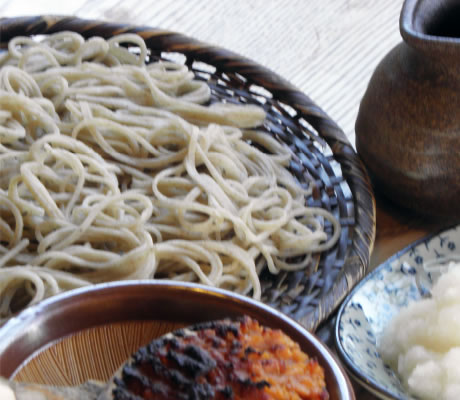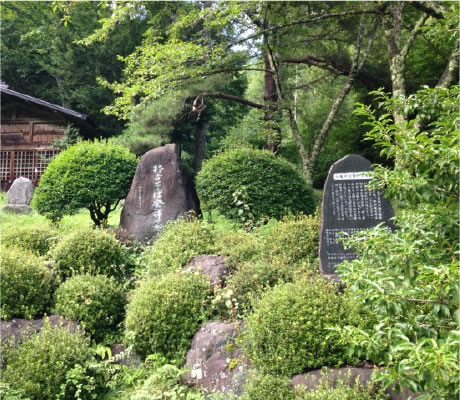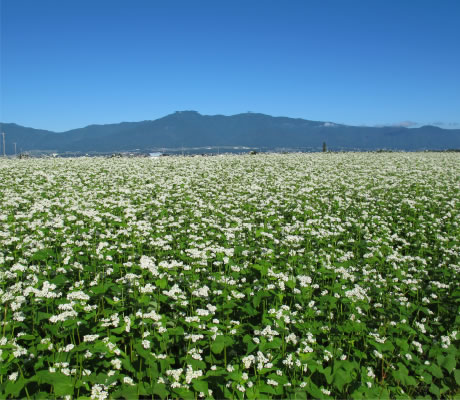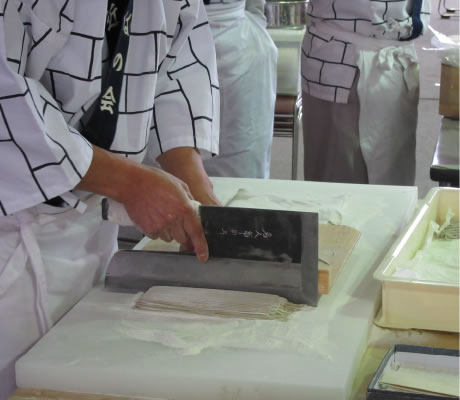Soba dishes are low in calorie content but highly nutritious. They contain protein, fat, carbohydrates, ash, minerals, dietary fiber and rutin. Then they are very healthy foods.
“Rutin” is the component to lower blood pressure and blood sugar levels as well as to activate pancreatic function, but it is only contained in “Soba”. Ingestion of rutin together with vitamin C enhances the property to strengthen blood vessels. These are the reason why “Soba” is standing in the center of attention as a food rich in nutrients and good for digestion.
Ina_the birthplace of Shinshu Soba
Ina City is famous for “Sakura” (cherry blossoms) and “Soba”.
The word “Soba” includes Soba as a type of cereals, Soba-ko (buckwheat flour), Soba-gaki (buckwheat dumpling) and Soba-kiri (buckwheat noodles). Berries of Soba are milled into flour and further processed into dumpling or noodles to eat.
The most popular Japanese foods are “Sushi” and “Tempura”.
“Soba-kiri” (generally called as “Soba” or “Nihon Soba”) is also one of popular foods in Japan, but not so popular in the world.
We introduce “Soba” here, which every Japanese loves very much and eats frequently.
The most popular Japanese foods are “Sushi” and “Tempura”.
“Soba-kiri” (generally called as “Soba” or “Nihon Soba”) is also one of popular foods in Japan, but not so popular in the world.
We introduce “Soba” here, which every Japanese loves very much and eats frequently.
Soba” is a food of a long history. It is said that Soba (cereal) has been cultivated since the tenth century B.C. (“Jomon Period”). The word “Soba” first appears on a book in 722 (in the “Nara Period”, about 1300 years ago). The book says that “En-no Ozunu”, the founder of “Shugen-do” (an asceticism sect in Buddhism), came to Shinano-no Kuni (Nagano prefecture) from the current capital Nara and sought out the first place of training at the mount Nishi Komagatake. He gave seeds of Soba, which is a type of cereals growing even under a severe environment, to the residents of “Uchino-kaya” (a community at the foot of the mountain), who took care of him, and instructed about the cultivation method. The Soba cultivated in the area has been called as “Gyoja Soba” (Soba instructed by a practitioner of Shugen-do) later. The seeds of Soba were expanded by traveling Buddhists to the areas at the foot of each holy mountain around the country (the legend of Gyoja Soba). It is the reason why it is said that there is Soba at the areas where residents have strong mountain worship. A monument of “the birthplace of Gyoja Soba” is placed in Uchino-kaya Community. Gyoja Soba Festival is held every year in the community and many people within and without the prefecture visit there for the festival.
Shinshu (Shinano-no Kuni or Nagano prefecture) is famous for Soba in Japan. In the province, Ina has especially been famous for quality Soba (cereal) harvest because of high altitude (600 to 3,00 meters above sea level), big day-and-night difference in temperature and soil suitable for Soba cultivation.
Soba grows even in poor soil environment, and crops on the 75th day or in about two and a half months after seeding. If you plant seeds of Soba in August, flowers bloom in September and you can harvest berries in the middle of October before winter.
“Soba” has been an emergency crop for people living in mountains where is unsuitable to rice cropping, so as to survive severe winter.
Soba grows even in poor soil environment, and crops on the 75th day or in about two and a half months after seeding. If you plant seeds of Soba in August, flowers bloom in September and you can harvest berries in the middle of October before winter.
“Soba” has been an emergency crop for people living in mountains where is unsuitable to rice cropping, so as to survive severe winter.
“Soba-kiri” (buckwheat noodles) was a popular food in the Edo Period. Hoshina Masayuki, a lord of Takano Domain in the Edo Period, liked “Soba-kiri” very much. He was an illegitimate child of the second Shogun, and later called as a ruler of virtue because of many good policies in Edo Bakufu (the Edo Shogunate). He transferred to Edo though a lord of Mogami Yamagata Domain and Aizu Wakamatsu Domain. He loved “Takato Soba”, dishes of “Omotenashi” (hospitality) in Takato Domain, and expanded Soba culture around the country through his life.
Q1:What is Takato Soba?
A. Classic style of buckwheat(soba) noodle in Japan before Edo era.Q2:What is Takato?
A. Takato is feudal domain name during Edo era and also is the birthplace of Takato soba.Q3:What has it characteristics?
A. Important characteristics are the fixings and cooking method. Peaple cultivate high-quality varietyin mountainous area, grind the seeds by stone rotary quern, and make flavorous noodle . The seasoning is constructed by baked soybean paste and grated pungent Japanese radish . The seasoning has been used before Edo era when soybean sauce became popular.Why not to come to Ina, the birthplace of Shinshu Soba, during your tour in Japan.
You will always enjoy delicious Soba dishes supported by the history.
We are heartily expecting your visit.
You will always enjoy delicious Soba dishes supported by the history.
We are heartily expecting your visit.














